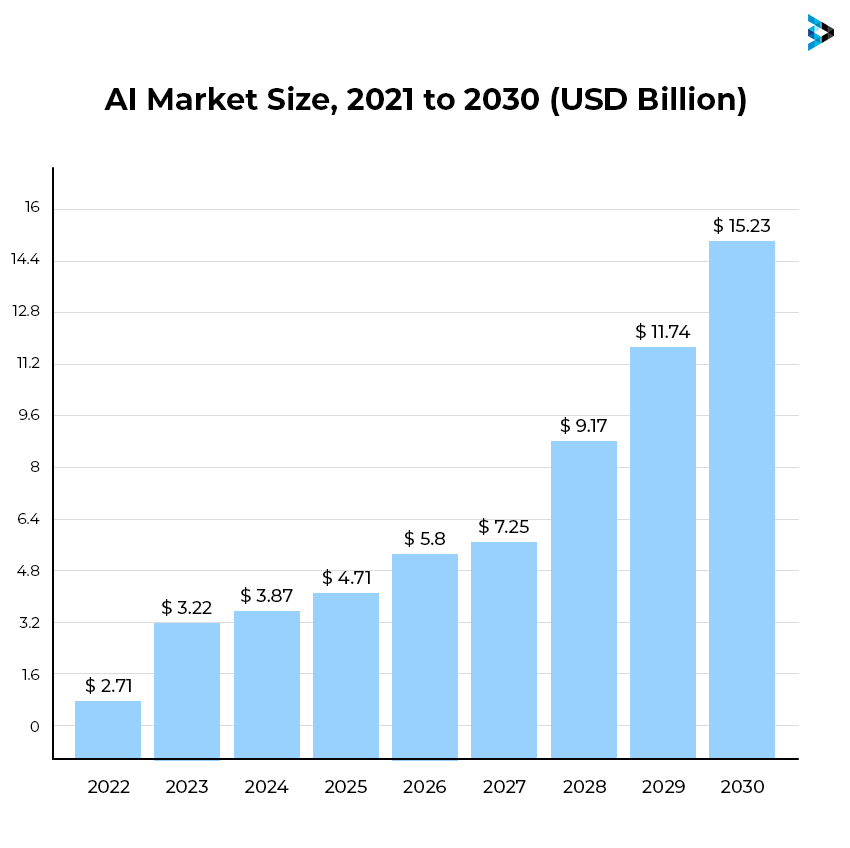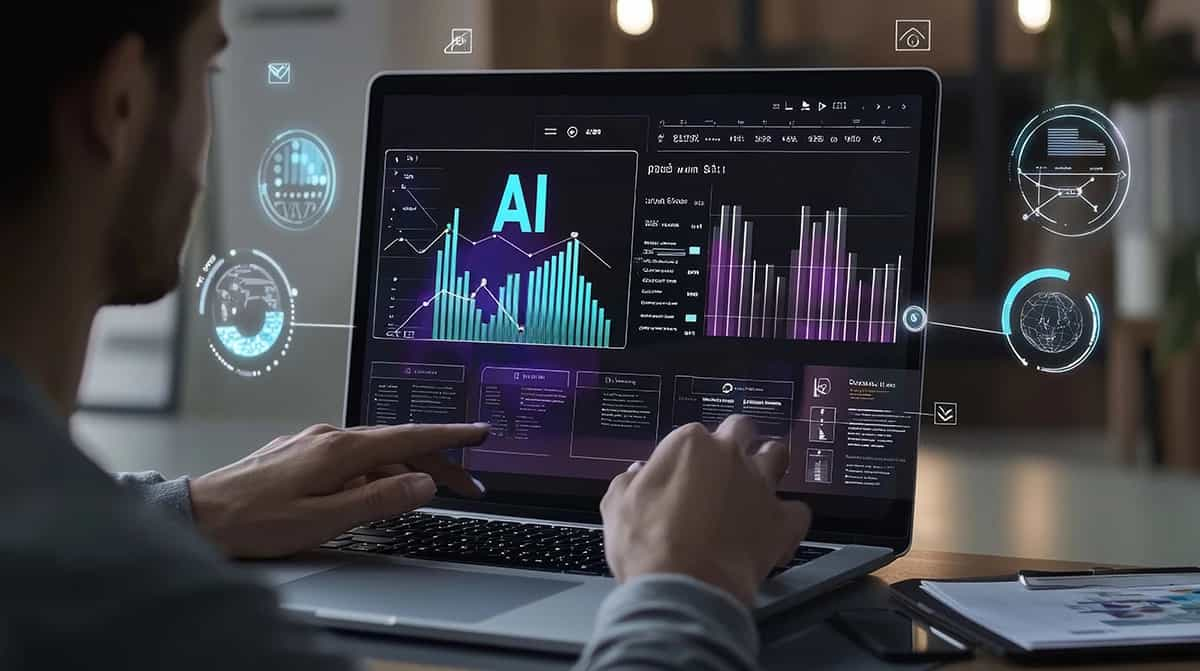Consumers today expect their automobiles to become as intelligent and personalized as their mobile devices and personal voice assistants. When combined with AI, many developing technologies and ideas, such as IoT data analytics, cloud computing, 5G, and big data, have unleashed new avenues for interconnection between cars and their surroundings.
The automotive environment is reshaped by generative AI, instilling intelligence in cars and fostering personalized driving experiences that adapt to individual tastes and demands. The age of rigid and standardized interfaces is over; these cars may now change their looks, displays, and controls, providing a completely tailored driving experience that seamlessly matches the user's choices.
Generative AI brings undeniable commercial advantages to the automotive sector. According to a top industry forecasting analysis, generative AI is anticipated to reach $2.3 trillion by 2032. This is a considerable increase from $271m in 2022, growing at a high pace of 23.4%.
The significance of generative AI in vehicle automation is critical. It aids in integrating critical parts of autonomous driving for vehicle automation.
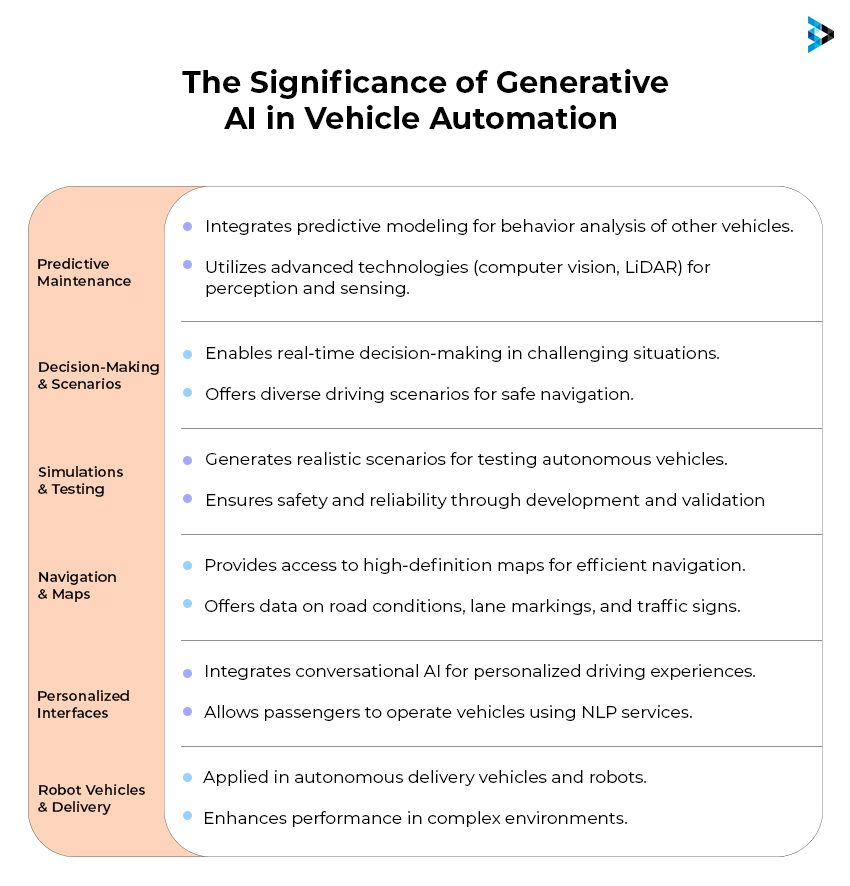
But how will this new technology impact the automotive industry? Let’s delve deep into how generative AI can alter the automobile sector.
Revolutionizing Automotive Design: Generative AI Use Cases
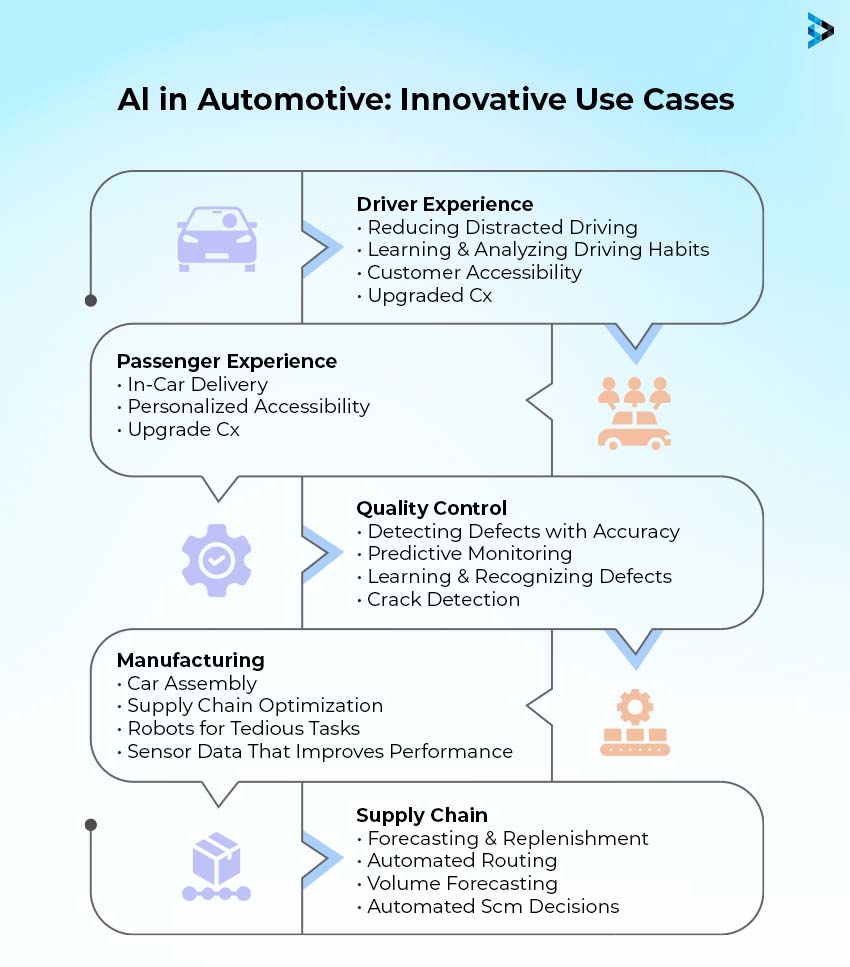
Connected Cars
In connected cars, the synergy of AI systems with IoT has revolutionized safety and user experience. Through Vehicle-to-Vehicle (V2V) communication, connected cars exchange real-time data for enhanced safety.
Moreover, Vehicle-to-Cloud (V2C) utilizes wireless LTE networks for OTA updates and remote inspections. At the same time, Vehicle-to-Infrastructure (V2I) ensures security by connecting with road infrastructure for real-time traffic, weather, and safety information.
AI in Designing
Generative AI revolutionizes automotive design, accelerating the iterative process. Analyzing extensive design data generates innovative options, speeding up exploration and enhancing the visual appeal.
The Japanese automaker Toyota recently exemplified this, leveraging generative AI to reconcile design and engineering considerations efficiently, saving time and costs in the development process.
NLP Voice Interaction
Utilizing NLP voice interaction, AI predicts vehicle breakdowns through sensor data, minimizing downtime and enhancing reliability. Advanced gesture and facial expression recognition enables hands-free controls and bolsters safety features.
Pioneered by companies like Tesla, this technology was integrated into their vehicles for proactive maintenance and cutting-edge safety advancements. These are the few elements that help with NLP voice interaction:
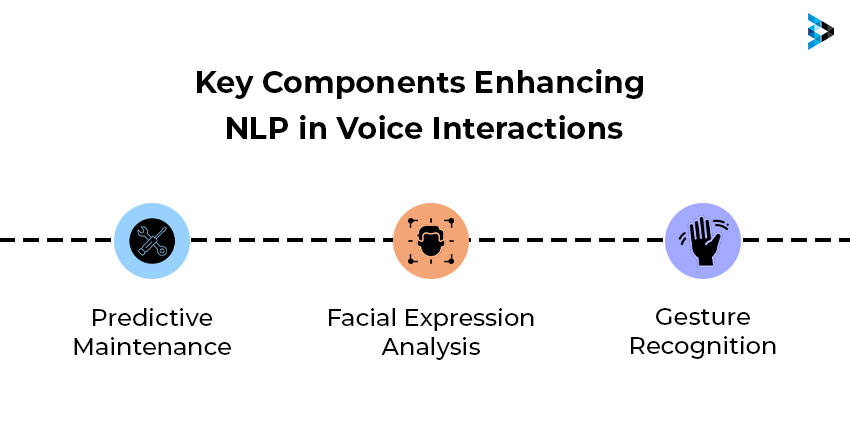
- Predictive Maintenance
- Gesture Recognition
- Facial Expression Analysis
You have already experienced this in your regular lives, in the form of Siri or Alexa. Now, it has emerged as a norm in our vehicles as well.
Customer Support and Service
IBM Watson Assistant, Nuance Automotive VA, and Aiqudo are just some of the ways AI can help you with customer service. But their uses are as follows:
- Automated Ticket Resolution: Generative AI handles routine customer queries, resolving issues efficiently.
- Personalized Assistance: Creates tailored responses based on customer preferences and history.
- Knowledge Base Enrichment: Updates and expands support databases for comprehensive customer assistance.
- Chatbot Integration: Enhances real-time communication for instant problem-solving.
- Continuous Learning: Adapts and improves responses through machine learning for ongoing customer support excellence.
Enhanced Navigation
Enhanced navigation, empowered by AI, revolutionizes conventional GPS systems. AI algorithms optimize routes using real-time data from diverse sources like traffic, weather, and driver behavior.
AI-Enhanced Navigation Capabilities:
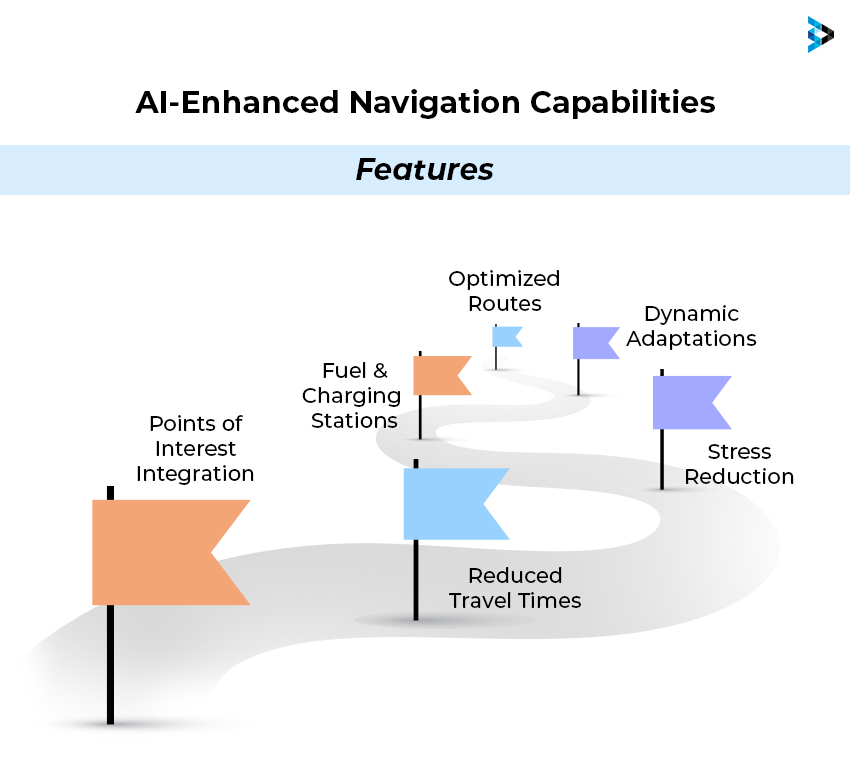
- Optimized Routes:
AI algorithms analyse real-time data for the most efficient paths, considering traffic and weather.
- Dynamic Adaptations:
Routes dynamically adjust to avoid congestion, accidents, and road closures for optimal navigation.
- Points of Interest Integration:
AI-driven systems include points of interest, enhancing navigation with personalized preferences.
- Fuel and Charging Stations:
Navigation considers fuel and charging station locations, catering to drivers' practical needs.
- Reduced Travel Times:
Efficient routing minimizes travel durations, improving the overall driving experience.
- Stress Reduction:
AI-driven navigation minimizes stress by offering smoother and dynamically adapted travel routes.
Emotion Recognition in Vehicles
Implement AI systems designed to detect and respond to the emotions of both drivers and passengers, enhancing the driving experience by personalizing and adapting to their emotional states. The US Department of Transportation claims that driving-related errors cause around 95% of fatal road accidents.
Facial Emotion Detection may identify minute changes in facial microexpressions that precede sleepiness and deliver personalized notifications to the driver encouraging him to take a coffee break, change the music, or modify the temperature.
Energy Management
AI-powered eco-driving systems may promote ecologically friendly driving habits, cutting carbon emissions and assisting with sustainability initiatives. AI, for example, may advise on mild acceleration and braking to cut down fuel usage and greenhouse gas emissions.
Data Security
Cybersecurity has become a major cause for concern as automotive technology grows in complexity, with millions of lines of code and constant communication. Automotive cybersecurity safeguards in-vehicle systems, communication networks, and related infrastructure against hostile attacks and vulnerabilities.
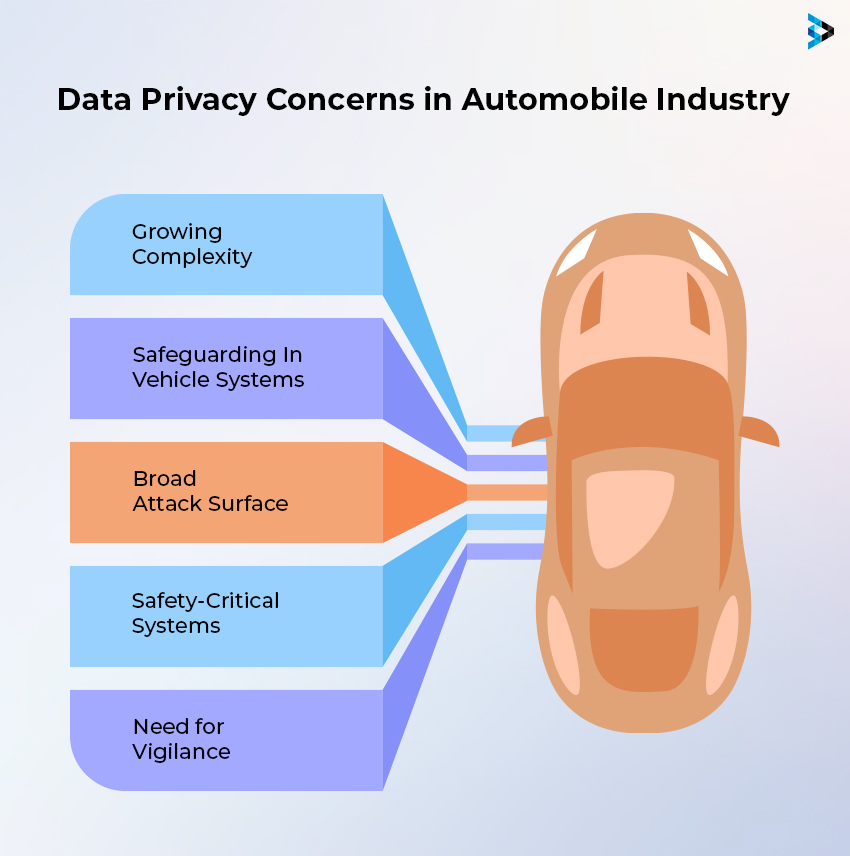
Automobiles now provide a broad attack surface because of the increased car connectivity via WiFi, Bluetooth, cellular networks, and V2X communications. Cybercriminals may exploit flaws in safety-critical systems such as brakes and steering.
Driver Assistance
Human mistake causes almost all automobile accidents, which may be prevented by Advanced Driver Assistance Systems (ADAS). The purpose of ADAS is to reduce the frequency of automobile accidents and the severity of those that cannot be prevented to minimize fatalities and injuries.
The following are examples of safety ADAS caused by Generative AI applications:
- Detection and avoidance of pedestrians
- Warning/correction for lane deviation
- Recognizing traffic signs
- Autonomous emergency braking
- Blind-spot detection
Autonomous Vehicles
Generative AI aids in real-time decision-making for autonomous vehicles. Self-driving cars use artificial intelligence to make real-time decisions based on the data they gather from their sensors. For example, if a self-driving car detects a pedestrian crossing the road, it will use AI to determine the best course of action, such as slowing down or stopping.
Driver Monitoring
The Driver Monitoring System (DMS) is a car safety device that uses artificial intelligence (AI) to monitor the driver's attention via a camera. Its objective is to identify the driver, monitor their levels of attentiveness using software, and notify them in instances of tiredness, distractions, and so on to avoid accidents.
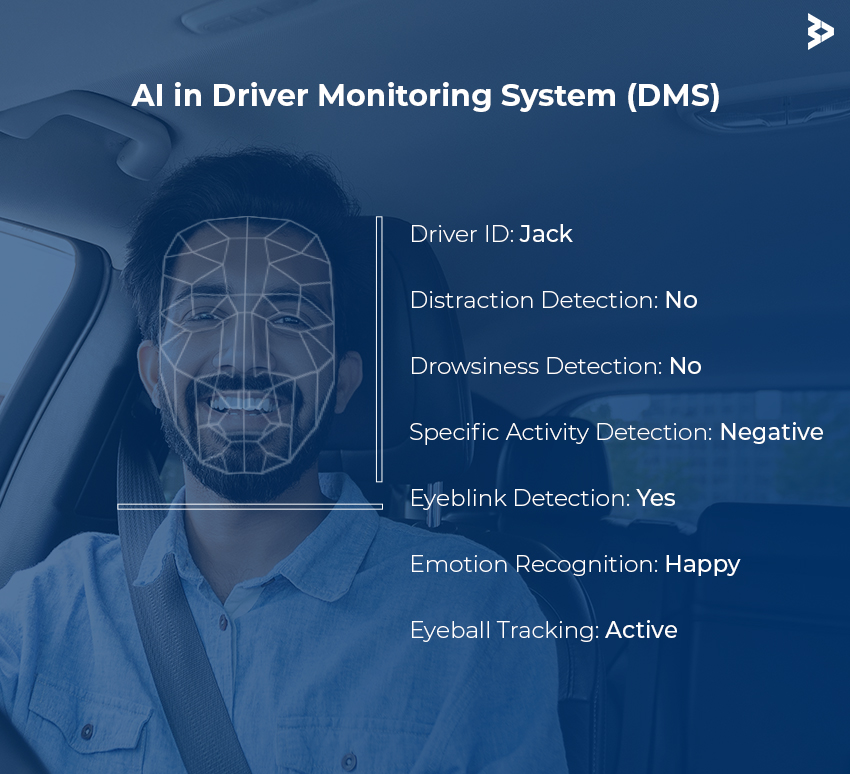
A camera mounted on the vehicle's steering column captures multiple movements and features of the driver using in-built sensors. The device can also identify how often the driver yawns, blinks or looks elsewhere. DMS's key characteristics are as follows:
- Driver ID
- Distraction detection
- Drowsiness detection
- Specific activity detection
- Eyeblink detection
- Emotion recognition
- Eyeball tracking
AI in Manufacturing
AI manufacturing solutions help improve warehouse order fulfillment operations. AI-powered systems can analyze incoming orders, optimize picking routes, and effectively deploy resources. This results in speedier order processing, fewer mistakes, and increased customer satisfaction.
BMW, for example, utilizes AI-powered automated guided vehicles (AGVs) in their production facilities to improve intralogistics processes. These AGVs go along specified courses, automating the movement of supplies and completed goods, thus improving inventory management and visibility for the organization.
Passenger Experience
AI enhances passenger experience through personalized in-car assistants, adjusting climate, entertainment, and seating preferences. Facial recognition enables customized settings, creating a seamless and enjoyable journey prioritizing safety and comfort.
Supply Chain Management
AI optimizes the automotive supply chain by predicting demand, automating inventory management, and streamlining logistics. It ensures efficient production, reduces costs, and minimizes delays, improving overall operational efficiency for manufacturers and suppliers.
Automotive Insurance
AI transforms automotive insurance with usage-based pricing, leveraging telematics data to assess driver behavior and set premiums. Claim processing becomes faster and more accurate through AI-powered image analysis, improving risk assessment and overall insurance experience.
Quality Control
AI revolutionizes quality control by automating inspection processes using computer vision and machine learning. It identifies defects in manufacturing, ensuring consistent and high-quality production. This enhances reliability, reduces recalls, and maintains brand reputation.
Autonomous Valet Parking
AI-enabled self-parking systems utilize advanced sensors and algorithms to navigate vehicles seamlessly to designated parking spaces. This ensures efficient use of parking areas, reduces congestion, and enhances the convenience and safety of parking for users.
Driving Efficiency: AI's Automotive Advantages
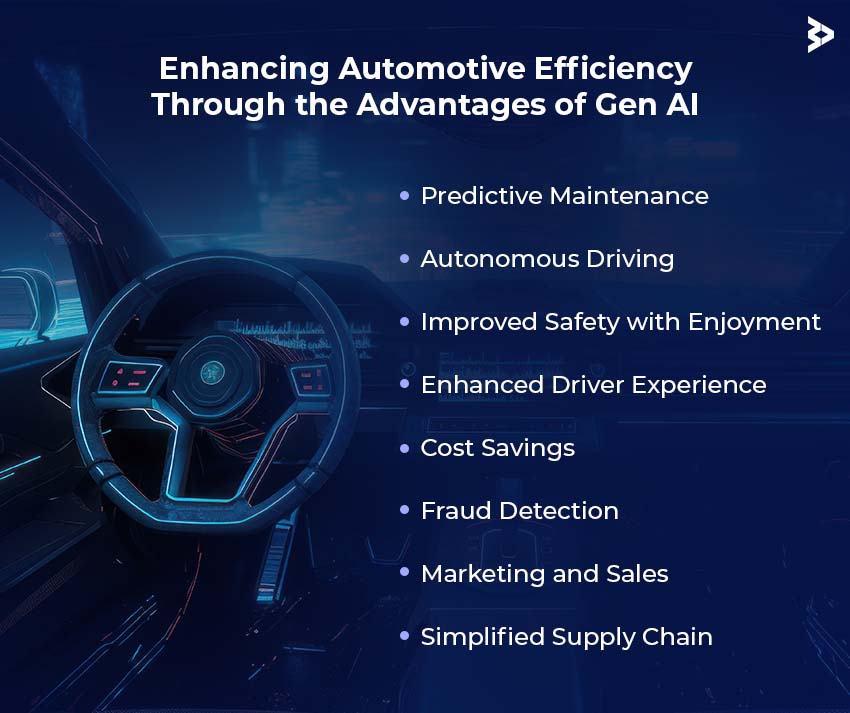
Predictive Maintenance
Implementing Predictive Maintenance using AI offers a wide range of benefits:
- Cost Savings: By detecting problems before they occur, car owners may prevent expensive breakdowns and significant repairs.
- Predictive Maintenance: It improves overall vehicle safety by addressing possible faults as they arise, lowering the chance of accidents caused by component failures.
- Higher Vehicle Uptime: With proactive maintenance, vehicles spend less time in the workshop, resulting in higher uptime and production.
- Improved Customer Experience: Vehicle owners benefit from fewer maintenance-related difficulties and unexpected failures, which improves customer satisfaction.
- Extended Component Lives: Regular monitoring and prompt maintenance may increase the longevity of important components, optimizing their performance over time.
Autonomous Driving
- Improved vehicle safety through AI technology.
- Enhanced convenience in autonomous driving.
- Streamlined transportation with efficient AI algorithms.
- Increased investment in research and data.
- Infrastructure development for AI-driven advancements.
Improved Safety with Enjoyment
AI in the automotive industry ensures improved safety by enabling advanced driver-assistance systems. These systems enhance vehicle control, collision prevention, and emergency response, fostering a secure driving environment. Simultaneously, AI contributes to an enjoyable driving experience through features like personalized assistance, entertainment, and seamless connectivity, elevating overall satisfaction for drivers.
Enhanced Driver Experience
| Benefits | Description |
| Personalized Assistance | AI enables tailored driving support and preferences. |
| Advanced Entertainment | In-car AI systems provide immersive multimedia. |
| Seamless Connectivity | Enhanced connectivity for communication and updates. |
| Intelligent Navigation | AI-driven navigation for efficient and smart routing. |
| Predictive Maintenance | Proactive maintenance alerts based on AI analytics. |
Cost Savings
By leveraging AI, automotive manufacturers can pinpoint avenues for heightened efficiency, superior quality control, and cost-effectiveness. Statistical data indicates that AI-driven automation may slash production costs by up to 20%, translating to an anticipated annual savings of $5 trillion by 2030. A survey forecasts a 39.4% compound annual growth rate in the global AI market from 2022 to 2030, projecting a total revenue of $1591 billion.
Fraud Detection
- AI analyzes transaction patterns for fraud.
- Predictive analytics assess historical data for proactive fraud prevention.
- Biometric tech enhances identity verification, reducing risks.
- Real-time monitoring flags suspicious activities for immediate intervention in automotive transactions.
- Geospatial analysis detects anomalies in vehicle locations, aiding in identifying stolen cars or fraudulent claims.
Marketing and Sales
- AI refines marketing efforts targeting specific customers with personalized content.
- Cost-effective, swift, and efficient compared to traditional mailers or cold calling methods.
- Tailored approach leverages data to offer relevant inventory, offers, and details to interested customers.
- Enhances lead generation and deal-making effectiveness for dealerships using precise, data-driven strategies.
Simplified Supply Chain
AI is used to optimize supply chain operations in the automotive industry. Machine learning algorithms, often implemented by specialized machine learning development services providers, use historical data, market trends, and external factors to forecast demand, enabling manufacturers to enhance efficiency and reduce costs.
Illustrating AI in Action: Real-Time Examples
Tesla

Tesla has revolutionized the automobile business with its inventive use of technology, notably in the field of artificial intelligence (AI). One of the most visible applications of Tesla's AI technology is the Autopilot advanced driver assistance system, which allows the vehicle to undertake a variety of driving duties such as lane keeping, adaptive cruise control, and automated emergency braking. However, Autopilot is only one of several AI-powered technologies in Tesla vehicles that have helped them become so popular with customers.
BMW

AI Integration Across BMW Departments:
- From R&D to administration and customer support, AI is implemented company-wide.
- Utilization of Natural Language Processing (NLP) technology enhances customer, employee, and business interactions.
AI in Customer and Employee Support:
- Intelligent Personal Assistant aids customers directly in vehicles.
- Translation tools and context-processing assistants assist employees in administrative processes.
AI in Energy Management and Image Processing:
- Machine Learning and data analysis optimize energy usage in buildings and vehicles.
- Image processing AI supports customer driver assistance systems and production processes for employees.
BMW's Next-Gen Infotainment System (iDrive 8):
- Revealed in March 2021, iDrive 8 incorporates machine learning, NLP, cloud, and 5G technologies.
- Designed as a digital, intelligent, and proactive partner for drivers.
Applications of AI in BMW:
- Research and Development:
- AI-based system for in-vehicle energy management.
- Acoustic signal processing for environmental monitoring.
- Automated translation and checking of over 33,000 requirement specification documents.
- Supply Chain Management and Logistics:
- AI application in Steyr plant expedites logistics processes.
- Recognition of containers' needs through image data.
- AI aids robotics applications in virtual layout planning for improved navigation and efficiency.
Mercedes Benz

The widespread application of gen AI is poised to yield an annual impact ranging from $6 trillion to $8 trillion across various sectors. Mercedes-Benz exemplifies Gen AI's automotive debut, employing ChatGPT in a beta program for over 900,000 vehicles. Skogstad details the implementation, emphasizing swift software iteration. The discussion delves into Mercedes-Benz's data privacy and security approach, exploring gen AI's potential in repair, sales, marketing, and R&D within the automotive value chain. The conversation concludes with insights and potential risks for automotive leaders.
Nvidia

NVIDIA's automotive solutions provide the power and scalability for envisioning, designing, and simulating the future of driving. Utilize NVIDIA AI, Omniverse™, and accelerated computing platforms to craft virtual showrooms, design car configurations, implement in-vehicle AI assistants, and validate autonomous driving technology.
Navigating Automotive Industry Challenges Successfully
Fundamentals:
Consider essential details when engaging a data partner.
Verify end-to-end support and expertise in data annotation and viewing processes.
Level of Complexity:
Recognize the impact of complexity on project timelines and costs.
Seek guidance from a reliable data partner to address ontology size and multimedia challenges.
Localization:
Acknowledge the significance of customization for diverse markets, languages, and demographics.
Leverage data partners for linguistic expertise, style guides, and voice persona development.
Security:
Prioritize security in handling sensitive automotive data.
Choose data partners with options like secure data access, crowd and onsite services, private cloud deployment, on-premise deployment, and SAML-based single sign-on.
Retraining:
Emphasize the importance of regular model updates to address changing conditions.
Leverage a data partner for retraining, including relabeling data and human evaluators for accurate analysis.
AI Potential in Automotive: Explore Limitless Innovations with Brainvire
Now that you know how AI can be beneficial for the automotive industry, make the most of Brainvire’s expertise to maximize the potential of AI in automotive.
From enhancing efficiency in manufacturing processes to creating intelligent vehicle assistants, we can guide you in leveraging AI to replicate human capabilities and drive innovation in the automotive industry.
Discover limitless possibilities with Brainvire's AI solutions.
Read more: Generative AI In ECommerce: Transforming The Online Shopping Experience
FAQs:
- What is the future of AI in vehicles?
The automotive industry is experiencing a revolutionary shift propelled by AI investments. ML data quality for autonomous driving, ensuring precision and safety. AI also promotes eco-friendly practices in electric car manufacturing, shaping a future of smarter, safer, and more efficient automobiles. Also, 5G connectivity transforms car systems into informative AI-driven assistants, optimizing operations, improving safety, and delivering personalized vehicle experiences beyond industry expectations.
- What tools are used in Generative AI for the automotive sector?
Tools like Generative Adversarial Networks (GANs) are used to create realistic vehicle images for design and simulation purposes. Variational Autoencoders (VAEs) are used to generate diverse variations in automotive design. Neural Style Transfer adds artistic elements to visual automotive components, while DeepDream enhances feature interpretation for detailed analysis. Pix2Pix is utilized for realistic image-to-image translation, contributing to the creation of lifelike automotive renderings and designs.
- How do you integrate AI into vehicles seamlessly without compromising functionality or safety?
Seamless integration of AI into vehicles without compromising functionality or safety requires rigorous testing and validation. Implement robust algorithms, prioritize cybersecurity, and ensure real-time responsiveness. Collaborate with industry experts, adhere to safety standards, and conduct extensive trials to help AI functionalities to enhance, rather than jeopardize, overall vehicle performance and safety.
- What measures can be taken for AI systems to meet top safety standards across diverse driving conditions?
Using sensors, cameras, and complicated algorithms, AI can analyze data and make split-second decisions to avoid accidents. Lane departure alerting systems, for example, use sensors to detect when a vehicle drifts out of its lane and alert the driver to correct it.
- What are the methods to collect, manage, and secure AI-generated data in compliance with privacy regulations?
To comply with privacy regulations for AI-generated data: Know AI laws, create a strong data governance framework, assess ethical implications, ensure transparency, conduct Privacy Impact Assessments, and enforce data retention policies.
- What are the opportunities for industry collaborations to enhance vehicle AI capabilities?
Industry collaborations offer abundant opportunities to enhance vehicle AI capabilities. Establish research partnerships with academic institutions for algorithm advancements. Forge technology alliances with AI-focused tech companies to access cutting-edge solutions. Collaborate with suppliers for seamless AI integration into vehicle systems. Embrace cross-industry partnerships to adapt diverse AI innovations. Engage with government and regulatory bodies to align AI development with industry standards.
- What are the strategies to continuously update AI models to adapt to evolving conditions, regulations, and consumer preferences?
Stay abreast of AI advancements by participating in events and webinars highlighting the latest research, applications, and best practices. Explore local or global conferences, workshops, hackathons, and meetups tailored to your interests and goals.
- What programming languages are prevalent in developing AI algorithms for automotive applications?
Python is predominant in developing AI algorithms for automotive applications due to its versatility, extensive libraries (like TensorFlow and PyTorch), and a supportive community. C++ is also common for performance-critical components.
- Are there open-source AI software frameworks or tools specifically tailored for automotive development?
Yes, there are open-source AI software frameworks and tools tailored for automotive development. Those AI tools include Apollo by Baidu, Autoware by Tier IV (for ROS), Openpilot by comma.ai (assisted driving), TensorRT by NVIDIA (GPU optimization), and PolyCoder by Huawei (voice assistants).
Related Articles
Digital Transformation
RAG (Retrieval-Augmented Generation): Making LLMs Smarter with Real-Time Data



